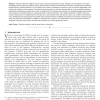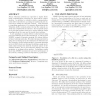113
click to vote
NETWORK
2010
14 years 7 months ago
2010
A primary goal of intelligent transportation systems is to improve road safety. The ability of vehicles to communicate is a promising way to alleviate traffic accidents by reducin...
133
Voted
TMC
2011
14 years 7 months ago
2011
—Vehicular networks (VANETs) can be used to improve transportation security, reliability, and management. This paper investigates security aspects of VANETs within a game-theoret...
93
Voted
ICUMT
2009
14 years 10 months ago
2009
Epidemic or gossip-based algorithms have been proposed for data dissemination in vehicular networks. Due to the unfeasibility of deploying large size vehicular networks, the perfor...
110
click to vote
CONEXT
2010
ACM
14 years 10 months ago
2010
ACM
Abstract -- We present VCD, a novel system for enabling high-bandwidth content distribution in vehicular networks. In VCD, a vehicle opportunistically communicates with nearby acce...
106
Voted
VTC
2010
IEEE
14 years 11 months ago
2010
IEEE
Abstract—VANET protocols need to exploit the special structure of vehicular networks. This structure includes the onedimensional nature of roads, the structure of lanes, the grou...
135
Voted
IJAHUC
2010
14 years 11 months ago
2010
Abstract: Efficient content distribution is one of the emerging applications in vehicular networks. To provide scalable content distribution in vehicular networks, Chord peer-to-pe...
170
Voted
SCN
2008
Springer
15 years 17 days ago
2008
Springer
Relative location information helps build vehicle topology maps. Such maps provide location information of nearby vehicles to drivers. In building a vehicle topology, one must cons...
108
Voted
PAAMS
2010
Springer
15 years 4 months ago
2010
Springer
A vehicular ad hoc network (VANET) is a type of mobile network whose nodes are traveling cars which communicate with one another using short-range wireless communications. These ca...
137
click to vote
MOBICOM
2004
ACM
15 years 6 months ago
2004
ACM
Future vehicular networks are expected to deploy shortrange communication technology for inter-vehicle communication. In addition to vehicle-to-vehicle communication, users will b...
147
click to vote
MOBICOM
2005
ACM
15 years 6 months ago
2005
ACM
Vehicles equipped with wireless communication devices are poised to deliver vital services in the form of safety alerts, traffic congestion probing and on-road commercial applicat...



